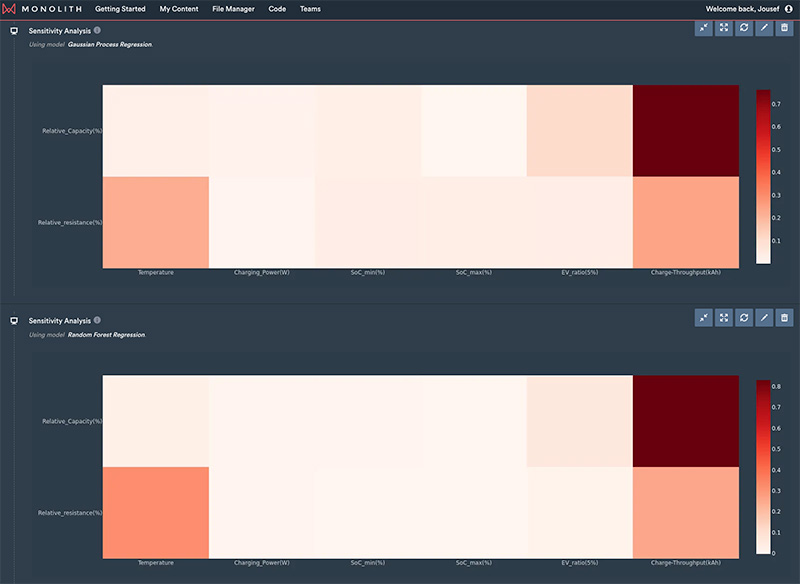Sensitivity Analysis for Battery Data
Understanding the Impact of Input Parameters
Batteries are essential to modern life, providing power to various devices and equipment. From the portable devices we use daily, like smartphones, tablets, and laptops, to more extensive applications, such as electric vehicles, backup power systems, and renewable energy storage, batteries play a crucial role in our daily lives.
With advancements in battery technology, we can now enjoy longer usage times, faster charging, and increased energy efficiency, making batteries an increasingly essential and reliable power source for our ever-evolving needs.
As the demand for energy storage continues to grow, the need for accurate battery models, risk analysis, and predictive analytics has become increasingly important. The rise of precise models, scenario analysis, and predictive analytics parallels the increase of sensitivity analysis in many industries.
Around the Global: Sensitivity Analysis on the Rise
Sensitivity analysis is a widely employed technique, including data analysis. Its primary purpose is to comprehend the impact of variations in input variables on the output of a system or model.
The technique helps identify crucial variables that exert the most significant influence on the results of separate models, for example, leading to a better understanding of the system's behaviour.
In the case of battery data, sensitivity analysis can be utilized to evaluate the influence of various factors on battery performance and behaviour.
Therefore, it is a valuable tool for battery manufacturers, researchers, and other relevant stakeholders who seek to identify the key factors that affect battery performance and behaviour.

With more accurate battery models, engineers can make better predictions for battery behaviour under different conditions, which can be investigated by other colleagues, departments or their customers in real-time using the shareable Monolith dashboard.
What is Sensitivity Analysis?
Sensitivity analysis is a method for understanding how different values of the variation in a model output can be attributed to different sources of variation in the model structure sample size of the model input variables.
In the context of battery data, sensitivity analysis can help us identify the most influential parameters and understand their effect on the model predictions. This can be particularly useful for identifying the key factors that affect battery performance and degradation.

The sensitivity analysis step shows visually how much impact each input of a model has on the different outputs of this model.
By examining the model's sensitivity to different inputs, it is possible to identify unexpected relationships and errors that might not have been apparent otherwise.
This information can then be used to refine the model and improve its overall accuracy. Sensitivity analysis is an iterative process that involves making incremental changes to the model and testing the results until the desired level of accuracy is achieved. Using sensitivity analysis to refine the model continuously makes it possible to create a more accurate and reliable tool for decision-making.
It might also help you to find patterns you weren’t aware of so far, improve your understanding of the (test) data behind the model, and guide you on where to concentrate your design and engineering efforts to improve product performance.
→ Watch the full webinar here.
Sensitivity Analysis for Battery Data
To ensure accurate predictions and estimation of relevant metrics, such as the state of health (SOH) or state of charge (SOC), existing physics-based and degradation models must be directly integrated into battery management systems (BMS).
These physics-based models have their inputs and variables defined and parameters obtained from historical data from simulations and other experiments conducted.
Engineers may not directly understand what degree of change can be expected by tweaking parameters in the model, resulting in an unsafe and uncertain prediction In the field of engineering, it is crucial to have accurate predictions to ensure safety and efficiency.
However, engineers may face challenges when predicting outcomes using models, mainly when tweaking model parameters.
Even slight adjustments to these parameters can significantly impact the overall prediction, making it difficult for engineers to know what degree of change to expect. This uncertainty can result in unsafe and unreliable predictions, which can have severe consequences in various engineering fields.
Therefore, engineers need to clearly understand how changes to model parameters can affect predictions to ensure that their models produce accurate and reliable results.
Parameter Identification - One Click Away
Instead of manually tweaking these parameters in physics-based or data-driven models, you can directly see which parameters are the most influential and how they affect the model predictions when using sensitivity analysis.
To optimise it, it's essential to identify the key parameters that impact a battery's performance.
Several factors can influence a battery's performance, including temperature, charge/discharge rates, cycle life, and state of charge.
Temperature is a significant factor that can affect battery performance. High temperatures can cause a battery to lose capacity and reduce its lifespan.
Similarly, low temperatures can also cause a decrease in the battery's performance, and in some cases, it can even prevent the battery from functioning entirely.
Charge and discharge rates are other critical factors that can impact battery performance. Charging or discharging a battery too quickly can lead to a reduction in its capacity and overall lifespan.
A slower charging rate can help maintain the battery's performance and lifespan.
Cycle life refers to the number of times a battery can be charged and discharged before it starts to degrade. A battery's cycle life can be impacted by several factors, including usage patterns and depth of discharge.
Finally, a battery's state of charge can also affect its performance. A battery that is fully charged or fully discharged can experience reduced performance compared to one that is partially charged.
By understanding these key parameters, it's possible to optimize a battery's performance and extend its lifespan.

Perform Sensitivity Analysis With Varying Input Parameters
For observing the effect of input parameter on battery performance, change one parameter at a time while keeping others constant. For example, vary the charging rate and observe its impact on battery life.
Observing Output Changes
When analysing battery performance, it is important to consider the impact of changes in input parameters.
By examining how changes in parameters such as temperature, discharge rate, and charging rate affect the battery's capacity, voltage, and efficiency, we can gain valuable insights into which parameters have the most significant impact on performance.
This information can be used to optimize battery performance, extend battery life, and improve overall system efficiency.
By identifying the key parameters target variables that influence battery performance, we can make informed decisions about how to design, operate, and maintain battery systems for optimal performance and longevity.
Quantifying Sensitivity Analyses
Quantify the sensitivity of specific dependent variables of the battery system to each input parameter. This can be done by calculating the sensitivity coefficients of certain variables, which indicate the sensitivity and rate of change of the output of a particular dependent variable concerning changes in the input of a specific dependent variable.
Optimization and Decision-Making Using Sensitivity Analysis
Use sensitivity analysis results to optimize battery operation and inform decision-making processes. For instance, you might adjust charging/discharging protocols based on the sensitivity of the battery to different temperatures or current levels.
Sensitivity analysis tells you which parameters are impactful but not how to adjust them. For this, you need to use Monolith's optimisation steps.
Scenario Analysis: Different Sensitivity Analyses
One effective way of gaining a better understanding of how a battery behaves under different operating conditions is to simulate a range of scenarios by combining multiple input parameter variations. By doing so, you can explore various scenarios and observe the battery's behavior in each one.
This can be especially useful in identifying patterns or trends in the battery's performance, such as how it responds to changes in temperature, load, or other factors. With this knowledge, you can make more informed decisions about how to optimize the battery's performance and extend its lifespan.
Perform Sensitivity Analysis for Risk Assessment
Evaluate the sensitivity to potential risks associated with independent variables, with uncertainties in input parameters. Sensitivity analysis can provide insights into which parameters contribute the most to the outcome variability, helping in risk assessment and management.
Perform sensitivity analysis for Model Validation
The validation of battery models is a critical task in energy storage, and it relies on comparing sensitivity analysis results with real-world observations. In particular, the accuracy with which the model reflects the observed sensitivities is a key factor in determining the model's predictive capabilities. The successful validation of a battery model instills confidence in its ability to forecast the system's behavior under different conditions.
This process is essential for developing reliable and effective energy storage solutions, and it requires a rigorous approach that accounts for all the variables and complexities of the battery systems. By leveraging sensitivity analysis techniques, historical data, and real-world observations, researchers and practitioners can enhance the accuracy and reliability of battery models, thereby advancing the state-of-the-art in energy storage.

The sensitivity analysis of a battery model in action inside the Monolith notebook emphasises the influence of key factors.
The figure above is the output of a sensitivity analysis on a battery model showing the relative impact of Temperature, Charging Power, SOCmin, SOCmax, EV Ratio, and Charge throughput on the battery's Relative Capacity and Relative Resistance parameters. The heat map displays the relative impact of each input on the two outputs – where darker colours represent a more significant impact or influence on the output.
What if you can see both inputs, namely the relative capacity and relative resistance, are strongly impacted by the charge throughput, which is logical because that's the ageing parameter?
But you can also see that the EV ratio, which represents the driving behaviour, also impacts the relative capacity. You can also see that the operating temperature affects the Relative Resistance as much as it affects the Charge Throughput.
The Future of Sensitivity Analysis for Battery Data
As the field of AI for engineers and decision-makers continues to evolve, the need for reliable sensitivity analysis techniques and tailored solutions for engineering problems and decision-makers will become increasingly important.
With the rapid development of machine learning, there is a growing need for accurate data generation and effective data-driven strategies for engineers.
By conducting sensitivity analysis on battery data, one can obtain valuable insights into the factors influencing battery performance.
This will enable the enhancement of optimization strategies and informed decision-making in efficiently utilising and managing battery systems.
Artificial Intelligence or Machine Learning have become ubiquitous in the engineering sector, promising faster time-to-market and enhanced decision-making for product design. However, integrating and adopting AI is not a seamless process and demands a strategic and phased approach.




